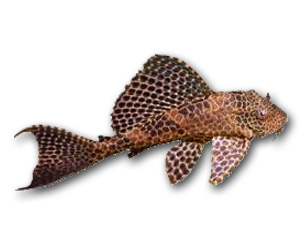Sailfin Pleco

Quick Stats
| Size | 20" (51cm) |
|---|---|
| Tank | 300 litres + when fully grown. |
| Swimming Area | Bottom, all surfaces in the tank and decor. |
| Ph | 6.4 to 7.6 |
| Temperature | 72ºF to 82ºF (22-28°C) |
| Food | Algae, veggies and sinking tablet foods |
Common Name:
Leopard Pleco, Sailfin Pleco, Leopard Plecostomus, Sailfin Plecostomus, Spotted Sailfin Pleco.
Distribution:
South American rivers (Peru).
Colouration:
Generally brown with yellow/white markings all over the body.
Lifespan:
25 years +
Maintenance:
10 to 20% weekly water changes. Even though they are herbivores they can get quite large and can become too big for small aquariums. Pleco or Plecostomus make very good community fish as they are peaceful with other tankmates. The only exception to this is they can get aggressive and territorial towards other plecos if they were not raised together.
Feeding:
Even though they are herbivores they can get quite large and can become too big for small aquariums. Keep some wood in the tank since rasping algae from the wood provides a perfect place for more algae to grow maintaining a constant food source for this fish. Also, the cellulose in wood is necessary for their digestive process. Herbivorous - Does eat algae but diet needs to be supplimented with algae wafers and/or fresh green vegetables such as spinach, romaine lettuce or zucchini slices.
Substrate:
Not critical. Its best to have a few rocks in the tank to allow algae to grow.
Tank Decor:
The tank should be very large with live or plastic plants and also lots of stones and driftwood. Plastic plans are probably a better choice as plecos can uproot plants in their search for food. Try to place hiding places for them as well. A plastic pipe or tube is a suggestion.
Filtration:
Standard filter suitable for the size of the tank.
Biotype:
Murky waters of the Amazon and other rivers of South America.
Breeding:
Very difficult simply due to space constraints. In the wild, they dig or utilize pre-dug caves excavated into the riverbank, amidst flooded charcos of questionable water quality. Thus, provided that size requirements are met, this species is likely fairly easy to spawn, as they are in southeastern Asia.